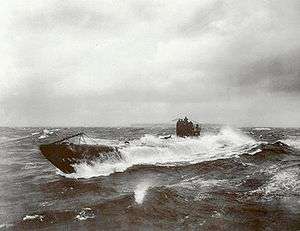SM UB-85
 UB-148 at sea, a U-boat similar to UB-85. | |
| History | |
|---|---|
| Name: | UB-85 |
| Ordered: | 23 September 1916[1] |
| Builder: | AG Weser, Bremen |
| Cost: | 3,341,000 German Papiermark |
| Yard number: | 285 |
| Laid down: | 24 January 1917 |
| Launched: | 26 October 1917[2] |
| Commissioned: | 24 November 1917[2] |
| Fate: | sunk 30 April 1918 by British warship at 54°47′N 5°23′W / 54.783°N 5.383°WCoordinates: 54°47′N 5°23′W / 54.783°N 5.383°W[2] |
| General characteristics [2] | |
| Class and type: | German Type UB III submarine |
| Displacement: |
|
| Length: | 55.85 m (183 ft 3 in) (o/a) |
| Beam: | 5.80 m (19.0 ft) |
| Draught: | 3.72 m (12 ft 2 in) |
| Propulsion: |
|
| Speed: |
|
| Range: |
|
| Test depth: | 50 m (160 ft) |
| Complement: | 3 officers, 31 men[2] |
| Armament: |
|
| Service record | |
| Part of: |
|
| Commanders: |
|
| Operations: | 2 patrols |
| Victories: | None |
SM UB-85[Note 1] was a Type UB III U-boat in the German Imperial Navy (German: Kaiserliche Marine) during World War I. Ordered on 23 September 1916, the U-boat was built at the AG Weser shipyard in Bremen and commissioned on 24 November 1917, under the command of Kapitänleutnant Günther Krech.[4]
Construction
SM UB-85 was built by AG Weser of Bremen and following just under a year of construction, launched at Bremen on 26 October 1917, and was commissioned later that same year. Like all Type UB III submarines, UB-85 carried 10 torpedoes and was armed with a 8.8 cm (3.46 in) deck gun. UB-85 would carry a crew of up to 3 officers and 31 men and had a cruising range of 8,180 nautical miles (15,150 km; 9,410 mi). UB-85 had a displacement of 516 t (508 long tons) while surfaced and 647 t (637 long tons) when submerged. Her engines enabled her to travel at 13.4 knots (24.8 km/h; 15.4 mph) when surfaced and 7.5 knots (13.9 km/h; 8.6 mph) when submerged.
Service history
On her second patrol, she was picked up by HMS Coreopsis off the coast of Belfast, Ireland on 30 April 1918, after she was partially flooded through a semi-open hatch while trying to evade attack by the British vessel.[4] The submarine was forced to surface and was abandoned by her crew while under fire. No casualties occurred amongst the 34 crew and they were taken as prisoners of war.
Relationship with cryptozoology
Under interrogation, the captain is reported to have said that the submarine had surfaced the night before to recharge the batteries and had been attacked by a large sea creature that had damaged the vessel and left it unable to submerge. The crew had fired their sidearms at the creature.[5]
Wreck
Engineers working on an electricity cable, the Western HVDC Link, discovered the almost intact wreck of a UB-III class submarine, believed to be either UB-85 or UB-82, lying off the Galloway coast in October 2016.[6] Dr Innes McCartney, a historian, nautical archaeologist and honorary research fellow at Bournemouth University, said, "We are certainly closer to solving the so-called mystery of UB-85 and the reason behind its sinking - whether common mechanical failure or something that is less easily explained."[5]
References
- ↑ Rössler 1979, p. 55.
- 1 2 3 4 5 Gröner 1991, pp. 25-30.
- ↑ Helgason, Guðmundur. "WWI U-boat commanders: Günther Krech". German and Austrian U-boats of World War I - Kaiserliche Marine - Uboat.net. Retrieved 9 March 2015.
- 1 2 Helgason, Guðmundur. "WWI U-boats: UB 85". German and Austrian U-boats of World War I - Kaiserliche Marine - Uboat.net. Retrieved 9 March 2011.
- 1 2 "Experts move a step closer to uncovering the mystery of the German submarine "attacked by a sea monster" in WWI". New Zealand Herald. 19 October 2016.
- ↑ "Wreck of German U-boat found off coast of Stranraer". BBC. 19 October 2016.
Notes
- ↑ "SM" stands for "Seiner Majestät" (English: His Majesty's) and combined with the U for Unterseeboot would be translated as His Majesty's Submarine.
Bibliography
- Bendert, Harald (2000). Die UB-Boote der Kaiserlichen Marine, 1914-1918. Einsätze, Erfolge, Schicksal (in German). Hamburg: Verlag E.S. Mittler & Sohn GmbH. ISBN 3-8132-0713-7.
- Gröner, Erich; Jung, Dieter; Maass, Martin (1991). U-boats and Mine Warfare Vessels. German Warships 1815–1945. 2. Translated by Thomas, Keith; Magowan, Rachel. London: Conway Maritime Press. ISBN 0-85177-593-4.
- Rössler, Eberhard (1979). U-Bootbau bis Ende des 1. Weltkrieges, Konstruktionen für das Ausland und die Jahre 1935 - 1945. Die deutschen U-Boote und ihre Werften (in German). I. Munich: Bernard & Graefe. ISBN 3-7637-5213-7.
External links
- Helgason, Guðmundur. "WWI U-boats: UB 85". German and Austrian U-boats of World War I - Kaiserliche Marine - Uboat.net.